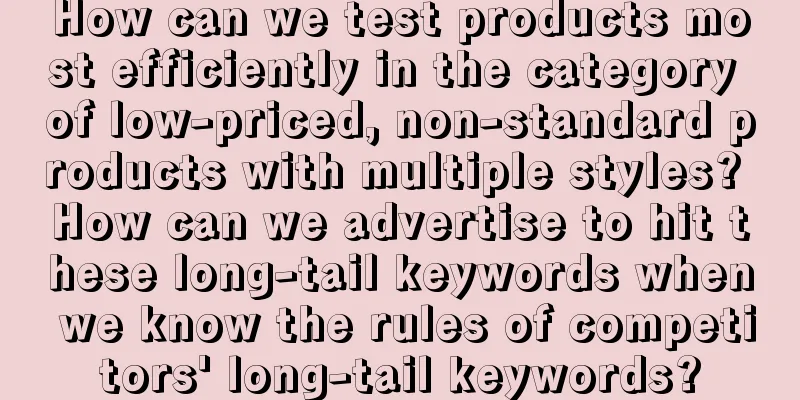|
coocool
Recently, I came across a store (non-standard products, vertical subcategories, small and light items) by chance, and then did some data analysis: there are many long-tail keywords in the category and they are scattered. Although the search volume is mostly only a few thousand, the CPC is very low and the number is also large; the market capacity is not large. For example, his store has dozens of SKUs, and the monthly sales are roughly 100-300, but many links are purely natural traffic; 1688 has a large supply of goods and rich styles, and the repetition rate of styles under the search results of the same keyword is very low. I want to try to enter this category. It is the first time to enter this category. There are no accumulated links. How can I test the style most efficiently? There are many problems that have not been solved:
1. Number of items tested:
Since it is a low-priced product, is it better to sell in small quantities and in multiple styles? For example, sell 60 styles at a time and only send 50 of each? ?
2. Evaluation:
How should I solve the problem of reviews because there are so many SKUs? I can only think of opening two free Vines directly after the product is put on the shelves. Are there any other methods? I have never tried QA, direct reviews or even order placement. Do I need to do it? Is it costly?
3. [Advertisement]:
This is the main problem. I want to imitate the advertising method of this store. If I already know the rules of the long-tail keywords of competitors, how can I advertise to achieve these long-tail keywords? How can I increase the number of traffic keywords?
4. Pricing:
Are products with multiple styles less price-sensitive? Since the value of the goods is not high, can we avoid using low-priced spirals?
5. Criteria for successful testing:
If we cast a wide net like this, and Vine gets two positive reviews, and then the ad runs and all 50 are sold out, does that count as a success? If we need to restock, should we restock the original link or reopen the link and merge the variants?
6. Playing method:
Do you have any suggestions for vertical category precision shopping and how to test models to increase the success rate? ? ?
"Wonderful Reply"
Anonymous user
Agree with: Lose weight? Regarding your question, I will reply based on my own experience, I hope it can help you
1. Number of items tested:
——Low-priced products have relatively affordable costs. Instead of launching 60 items at once, you can consider launching 30 items at once, with each item selling about 100. This can prevent a product from becoming popular midway, but the quantity sold is too small, which is not conducive to inventory connection. Under the acceptable trial and error cost, ensuring the energy for testing items and inventory connection is the best solution.
2. Evaluation:
——As for reviews, due to a large number of account scans in 2022, our company has not done reviews for a long time. Safety comes first. After all, it is not easy for everyone to open a store. You can consider opening a free vine directly, or spend some money to add more vines. It is safe and has a high evaluation weight. QA can be arranged. Compliance in this area is not strict at present. Direct reviews and order placement are not recommended because they are unsafe and not long-term. Direct reviews are easy to lose, and order placement is short-term benefit.
3. Advertising:
——Competitors have provided good reference samples for advertising. For low-priced products, we generally do not use too many big words or precise words in advertising, but a large number of medium and long-tail general words. This can control profits and achieve better exposure.
Advertisement formats that can be used for reference:
Automatically pick up bargains at low prices and let Amazon identify your products
SP format, a large number of medium and long tail broad format bid at a low price - add pause words in time, leaving words with high conversion
SP form of big words is not itself a broad form of bid low price - the purpose is to expand traffic and drive conversion
4. Pricing:
——It is originally a low-priced model, and everyone is still trying to raise the price. There is no need to make this product. Don’t use the low-price spiral strategy. Set the price normally. When you find out which model is the mainstream model, you can set the price of this model relatively low. To make up for the profit, you can raise the price of other models that are still selling well a little bit. In this way, you can make money to promote the main model + stabilize the profit.
5. Criteria for successful testing:
——It is recommended that when testing the model, if the trend is good, you can continue to arrange small and multiple replenishments. There is a good trend in the early new product period plus the virtuous cycle, and there is no need to reopen new links. The standard of success depends on your own definition. If it were me, this product could be sold, the star rating was good, and there was room for profit, I would continue to sell and replenish.
6. Other playing methods:
Testing models increases the success rate. I think this need should be put in place first. You should spend time to choose models that you think are good. More does not mean better, but choosing the right one is better than several.
Anonymous user 1. Number of items tested:
Since it is a low-priced product, is it better to sell in small quantities and in multiple styles? For example, sell 60 styles at a time and only send 50 of each? ?
To avoid risks, no matter the price is low or high, many companies will send small batches of products to Amazon for testing. Similarly, think from another angle, why do you send small batches for testing? For example, if you are not familiar with the market, send a small batch to familiarize yourself with the market; for example, if you are not sure about the color; for example, if you are not confident about the product quality, etc., first sort out these issues, and your subsequent thinking will be clear. Sending 20 each time is enough.
2. Evaluation:
How should I solve the problem of reviews because there are so many SKUs? I can only think of opening two free Vines directly after the product is put on the shelves. Are there any other methods? I have never tried QA, direct reviews or even order placement. Do I need to do it? Is it costly?
The compliant one is Vine. Whether you are testing a model or shipping a large quantity, you must apply for Vine after the goods arrive. Speed up the pace and don’t waste the new product period. Direct reviews are slow to show up. I usually arrange it more than a week in advance. Find a service provider to do it. Direct reviews cost more than 10 yuan, and QA costs about 5 yuan per group. It can be done. It is still very helpful for the early conversion of new products.
3. Advertisement:
This is the main problem. I want to imitate the advertising method of this store. If I already know the rules of the long-tail keywords of competitors, how can I advertise to achieve these long-tail keywords? How can I increase the number of traffic keywords?
You can find the root of these long-tail words and use broad advertising. If the traffic of these long-tail words is acceptable, you can directly use precise advertising. In the early stage of advertising, you can use core keyword precision and automatic advertising, and put all variants in. This is mainly for running words and getting familiar with the market. You can also use advertising to test which sub-body performs best. The best performing one will be used as the main promotion or advertising main.
4. Pricing:
Are products with multiple styles less price-sensitive? Since the value of the goods is not high, can we avoid using low-priced spirals?
You have already set the lowest price, and you can’t make it spiral. This low price also has an advantage, which is that you don’t have to worry about competitors coming in and spiraling in later.
5. Criteria for successful testing:
If we cast a wide net like this, and Vine gets two positive reviews, and then the ad runs and all 50 are sold out, does that count as a success? If we need to restock, should we restock the original link or reopen the link and merge the variants?
Clarify what your positioning is for the product? 10 orders per day? 20 orders? 50 orders? 30% profit. Drive around your own goals. For example, if you are very enthusiastic when you see that there are no comments on the product, then what will happen if there are comments later? This will definitely take off. Regarding testing, we will pay more attention to the conversion rate, as well as the input-output based on the conversion rate, and the sales trend of the product. For example, if it is expected to have 5 orders per day, and it can suddenly reach 10 orders, it means that the trend is good; if it only has 1-2 orders at the beginning, don’t rush to deny it. Make some evaluations first, adjust the advertisements, and see if the product conversion and sales will improve.
If your profit margin is low and the conversion rate of new products is poor (reviews have an impact), it is recommended to give up directly. Usually, we will promote products according to the established plan based on the current situation. If the traffic and product trends are good, then the real big product promotion will take off later? In this process, we look more at the conversion rate of the product and the trend of the product (generally the fluctuation and increase of traffic) to judge whether the product is feasible.
Restocking:
Because your link is a test product, the number is small and the weight is not accumulated enough, I suggest you re-list it:
1. If you replenish the stock directly and the goods cannot be connected, it will affect the promotion of the new product period, thus affecting the upper limit of the product.
2. Previous promotion experience also helps you verify some information: your advertising promotion ideas are generally correct, and you have a certain degree of understanding of copywriting and keywords. In other words, when you re-list the product, you are no longer crossing the river by feeling the stones, but accumulating certain category experience to operate this product, so that the upper limit of the product will be higher. (It is considered good to achieve a break-even in the early stage of the new product without comment)
3. The market won’t change much in the short term, so you still have enough time to change a new link to promote.
You need to be careful when re-establishing the link, and subsequently control the quality of the supply chain and do a good job of link maintenance.
6. Playing method:
Do you have any suggestions for vertical category precision shopping and how to test models to increase the success rate? ? ?
Then it comes back to product analysis and selection, followed by promotion; you can refer to the successful cases of a store for reference.
Anonymous user 1. Number of items tested:
Since it is a low-priced product, is it better to sell in small quantities and in multiple styles? For example, sell 60 styles at a time and only send 50 of each? ?
--------Since you have decided to stock the goods, you must buy them in small quantities and multiple times to see the effect and replenish them in time
2. Evaluation:
How should I solve the problem of reviews because there are so many SKUs? I can only think of opening two free Vines directly after the product is put on the shelves. Are there any other methods? I have never tried QA, direct reviews or even order placement. Do I need to do it? Is it costly?
--------You can give priority to some SKUs as preferred products for testing. You can try Vine, after all, it is an official review channel.
3. Advertisement:
This is the main problem. I want to imitate the advertising method of this store. If I already know the rules of the long-tail keywords of competitors, how can I advertise to achieve these long-tail keywords? How can I increase the number of traffic keywords?
--------First, hit the long tail widely, and then hit the big words widely after stabilization in the middle and late stages
4. Pricing:
Are products with multiple styles less price-sensitive? Since the value of the goods is not high, can we avoid using low-priced spirals?
--------Not necessarily. It depends on the average price, whether the demand is rigid or necessary, and the repurchase rate.
Prioritize regular prices, look at ads first, and sell first. The goods I sell are of higher value, so I generally don’t use low prices. Low prices are endless.
5. Criteria for successful testing:
If we cast a wide net like this, and Vine gets two positive reviews, and then the ad runs and all 50 are sold out, does that count as a success? If we need to restock, should we restock the original link or reopen the link and merge the variants?
---------The original link has weight, the original link is given priority for replenishment
6. Playing method:
Do you have any suggestions for vertical category precision shopping and how to test models to increase the success rate? ? ?
---------In advertising, be objective and don't have subjective preferences. All models must have advertising traffic, and the advertising traffic obtained should be balanced.
Anonymous user “Since it’s a low-priced product, isn’t it better to have a small number of different products?”
For low-priced products, it is okay to arrange a larger quantity, because there are few orders, and the conclusions drawn from too small a quantity will be limited.
If you put 60 SKUs on the shelves at once, it is not recommended to put 50 of each. You should at least know which products are in season, which are off-season, which markets are active, and which markets are inactive. You are not required to know very detailed information, but at least the category direction should be determined. For suitable categories, prepare about 50. For unsuitable categories, prepare 20 to 30.
"How should we solve the problem of evaluation when there are many SKUs?"
You have so many SKUs, 2 free vines are enough, direct evaluation and QA are unnecessary, just distribute the goods according to the distribution, and if you also do evaluations for distribution, then you need to test what goods and models you distribute...
"How can we advertise to achieve these long tails? How can we increase the number of traffic words?"
Please refer to the attachment for a large number of keyword strategies.
“Are people less sensitive to price for this kind of multi-style product? Because the value of the product itself is not high.”
Whether it is sensitive or not, you can only know it after experiencing it, and it also depends on the category. Non-standard products are generally less sensitive to price than standard products. But whether you want a low-price spiral depends on your pressure, and it is not something that can be found out by asking...
“The standard for successful testing”
After selling this batch of goods, check the turnover speed, gross profit margin, promotion fee ratio, head-mile ratio, purchase ratio, and market capacity trend. Some of them are just good for you during this period. When the active period has passed after the large shipment, you need to clear the inventory... The more goods you ship, the more points you need to consider. As long as the original link is fine, ship to the original link, and prepare the seed link at the same time to avoid bad reviews after the goods arrive because of secondary sales.
The attachment is for additional reference. There are also many test posts and suggestions on the forum, which can be referred to:
https://www.wearesellers.com/question/18016
https://www.wearesellers.com/question/68993
https://www.wearesellers.com/question/66027
https://www.wearesellers.com/question/60145
https://www.wearesellers.com/question/56125
Anonymous user
Question 1:
The basis for determining the quantity of new product shipments is:
1. The delivery method affects the quantity of new products. If you choose Meisen, the time for delivery and product listing is 30 days. At least you have to wait until your product has a certain performance before restocking, right? It takes more than 40 days for the next batch of Meisen to arrive at the warehouse. In other words, you must guarantee at least 50 to 60 days of sales for your first batch of goods.
2. Choose a target precise competitor, which is the sales target of the first phase of the product. For example, if your goal is to reach the 200th place in the subcategory in the first phase, then look at the sales of the 200th place in the subcategory. Here, we assume that the monthly sales volume is 200.
3. Fluctuations in product market demand. Especially for seasonal products, we need to consider the growth of future market demand and appropriately expand the shipment quantity. For example, if the future market demand is incremental, then the market incremental coefficient is 1.2 (if the market is stable, the coefficient is 1, you can judge the incremental coefficient yourself)
So the formula for new product delivery is:
Shipping quantity = Shipping time * Target ranking monthly sales volume * Market increment coefficient
Question 2:
In the process of product selection, after basically confirming a product, we will buy samples to refer to the advantages and disadvantages of multiple samples, and then make some differentiation according to the pain points of buyers. So after we call the factory for production of the final confirmed product style, we will immediately select the better quality ones from the samples, upload the link and ship 50 or 60 to the Amazon warehouse for green labeling, and directly apply for 30 stocks to Amazon and pay $200.
What are the benefits of doing this?
1. It completely avoids the problem of duplicate distribution as mentioned above, and the risk of getting two green labels for free and taking advantage of Amazon. It also ensures that the products developed later will have comments as soon as they are launched.
2. Test data. What data should be tested? For example, CPC, conversion rate and organic order ratio of certain keywords in the advertisement. Prepare in advance for the promotion of new products.
|










